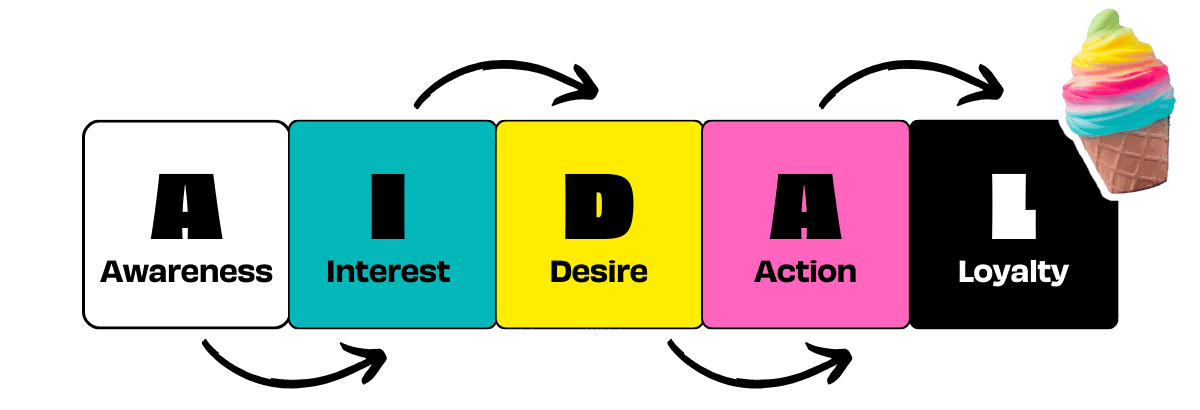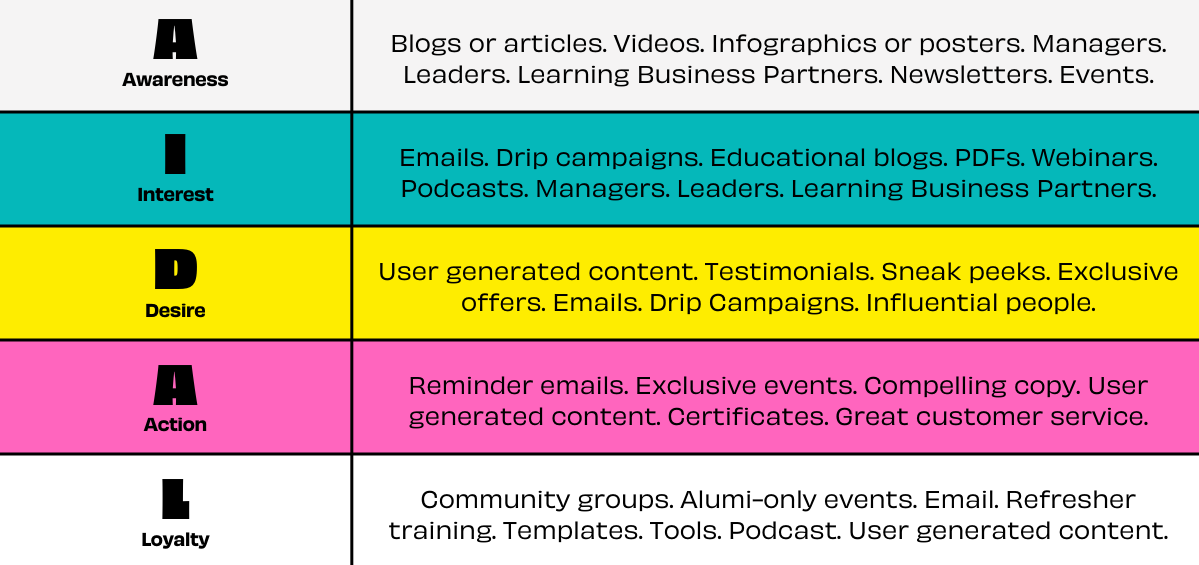want some cookies?
We use cookies to make your browsing experience amazing.

TL;DR: DECISION MAKING JOURNEYS
Think your learners don’t have a decision when it comes to engaging with your learning? Think again. In fact, they go through a whole journey in deciding whether to engage with you or not. And if you want your marketing to be impactful, you’ve gotta understand that journey.
WTF IS A LEARNER DECISION MAKING JOURNEY?
Ever feel like you’re screaming into an empty room when trying to get your people engaged with learning? Yeah, we’ve all been there. We can send emails, put up posters, put on a pineapple costume and dance through the office – and still nobody shows any interest in learning. *Sigh*.
But what if I told you this doesn’t need to be the case? What if there was a secret to getting your people engaged with learning? It’ll save you banging your head off that wall, right?
So, drum roll please… the secret is finding out where your audience is hanging out, then going to them. No, this isn’t a revolutionary idea. But it’s one that’s so often overlooked in L&D that we need to talk about it.
In marketing we have a concept called the “customer decision making process”. And it is an activity to work out the steps an organisation’s target audience takes before, during and after purchase. Marketers will map out where their people are, what they’re thinking about and how they’re feeling at every single point of this journey. And it’s only after having that in-depth understanding of their target audience, does a marketer start thinking about marketing tactics.
So it’ll come as no surprise that a learner decision making journey is the same – but in a learning context. Duh.
WHAT IS A LEARNER DECISION MAKING JOURNEY?
A learner decision making journey is the process your target audience goes through – from initial awareness of your offering, through to getting involved and becoming advocates of your learning.
The decision making framework highlights all the actions, thoughts and feelings your audience will go through at each stage of the AIDAL model, enabling you to communicate with them in the most appropriate way for how they’re feeling right now.
OKAY, SO WHAT IS THE AIDAL MODEL?

AIDAL stands for Awareness, Interest, Desire, Action and Loyalty. And they are all the motions your audience will go through whilst dealing with you and your learning offering. It’s best to think of AIDAL as a funnel. In L&D, most, if not all, of your target audience will have some level of awareness of your offering – but that’s not good enough, is it? We want them learning! So our objective is to nudge them down the AIDAL funnel, in order to get them to get involved with your learning offering (action), and tell their friends, colleagues & peers about their experience (loyalty).
THE AIDAL MODEL
So now we know that the AIDAL model is a representation of our audience’s journey with learning, let’s look into each stage in a bit more detail…
STEP ONE: AWARENESS
The first step of the AIDAL model is awareness – and if you have a large cohort of employees who are unengaged with learning in your organisation, this is where they’ll be sitting. Simply put: they know your learning offering exists – but they’re not doing anything with it. They’re not engaging with it. They’re not talking about it. They’re not even thinking about it.
NOTE: It’s important to remember that an individual's stage in the journey has no correlation with their tenure at your organisation. Somebody could have worked for your company for decades, and still be in the ‘awareness’ stage of the learner decision making journey.
STEP TWO: INTEREST
The next stage of the decision making journey is interest. This is when your audience starts thinking about your learning offering, and how it might benefit them. They still haven’t decided if they want to get involved, if the offering is right for them, or if they deem the learning necessary at all. But they’re interested in it…
The best way to understand the interest stage is by thinking about the last new gadget you purchased. For me, it was my dishwasher. I spent a long while in the interest stage.. I knew the benefits of having one, I knew how it would impact my life, I was interested in having one. But I spent time weighing up whether it was right for me, whether it was worth the cost, and (probably most importantly!) if it would fit in my kitchen.
So in the interest stage your audience has realised they have a challenge, but they’re trying to work out if learning is the solution.
STEP THREE: DESIRE
The middle stage of the AIDAL model is where your audience ups the ante. They now want to take part in your learning offering. They’ve identified their problem, and they know they need to learn a new skill or way of working to fix it.
But this doesn’t mean they’re ready to go full steam ahead just yet. In fact, this is the stage in which your audience is most likely to be comparing you to another option. Is there another way they can acquire this skill or gain more knowledge on a particular topic? Maybe there’s an off the shelf course that would be easier for them to acquire and complete. Or maybe there’s some YouTube videos on the topic. Going back to my dishwasher example – I was in the desire stage (knowing I really wanted a dishwasher) but then I started comparing different types of dishwashers, before I made a purchase.
STEP FOUR: ACTION
This stage is pretty self explanatory, right? It’s the moment your audience takes action. They dive in and complete your learning intervention. Whether that’s completing an elearning course, enrolling on a face-to-face programme, or signing up to your mentoring scheme. Whatever ‘it’ is, they’re doing it.
Depending on your organisation, your L&D function and your marketing strategy, your action stage may be a small action, i.e. signing up for a learning intervention. Or it may be a long, complex action, for example completing a blended learning programme. I cannot tell you what your action should be, but make sure it’s defined up front – before you move on to considering what your audience are doing at this stage.
STEP FIVE: LOYALTY
The final stage in the AIDAL funnel is loyalty – and this is the most impactful for L&D. And the one that most of us dream of – having loyal learners to advocate for our offering. At this stage your audience is raving about your offering. They’re telling their friends, colleagues and peers about the experience they had, and the impact it had on them. Oh, and they’re coming back to you for all their future learning experiences, of course!
But nudging people into the loyalty stage isn’t always easy. In fact, people often share their negative experiences more freely than they share their positive experiences. So to get people to advocate for your L&D offering, you really need to knock their socks off.
THE DECISION MAKING FRAMEWORK
But before we dive straight in, it’s important to remember that the learner decision making framework is a task of empathy. It’s putting yourself in your audience’s shoes. And thinking about their activities, goals, thoughts and emotions at each stage. In its final form, the decision making framework is a matrix that gives us a holistic view of our audience’s experience with learning.

🛑 STOP 🛑 MUST READ BEFORE YOU CONTINUE! To accurately fill out your decision making framework, it’s important to have an in-depth knowledge and understanding of your audience. Learner Personas are the best place to start with this – so if you need to go and do some research, do that now!
Now our empathy comes into play. To accurately fill out the learner decision making framework, we need to think about what our audience are doing, thinking and feeling at each stage. It’s especially important to remove the learning lens for this task. The chances are your audience isn't thinking about learning as much as you are… so keep that in mind while filling out your framework. Now let’s dig into each step a little more, shall we?
ACTIVITIES
What are your audience doing at each stage of the funnel? What tasks are they completing? How are they spending their time? Remember to think outside of the box here. Remember! Not all of the activities will be learning related, your audience will likely be occupied with their day job, family life and social activities too! (And they’ll probably prioritise these over learning too!)
GOALS
As an L&Der, it’s easy to assume our audience’s goals will be learning related. Maybe you assume your people have a goal of learning a particular skill or acquiring a piece of knowledge. And that might be true for some. But the truth is, a large portion of your audience will have very different goals. For example, they might have the goal of getting a pay rise or promotion. Or maybe they’re striving towards the goal of the perfect work/life balance. For many – their goals will not be learning related, but the solution will be!
THOUGHTS & FEELINGS
We know that the decision making framework is a task of empathy, but when filling out the thoughts & feelings sections of your framework, you need to take this up a notch. You need to put yourself in the shoes of your audience and really think about how they might feel at that moment in time. Don’t rush past this part, spend time thinking about how to articulate their thoughts and feelings. And utilise the full wheel of emotions! Don’t settle for ‘happy’ – maybe your audience is optimistic and inspired. Instead of being scared, maybe they’re feeling overwhelmed and inadequate. Dig deep and articulate their emotions!
A WORD OF WARNING ABOUT POSITIVE INTENT
When completing your decision making framework, you must be realistic. Oftentimes we assume positive intent towards learning – but that isn’t a realistic depiction of your audience’s journey. Particularly in the desire, action and loyalty stages, make sure you’re being realistic about how your audience might feel. For example… What happens if someone has a bad experience with your learning offering? How might they feel? How might that impact them moving – or not moving – on to the ‘loyalty’ stage of the funnel? Be realistic, it’ll help you when it comes to marketing your offering.
FAQ: HOW MANY DECISION MAKING FRAMEWORKS SHOULD I CREATE? 🤔
We often get asked how many frameworks someone should complete, so if you’re wondering: you should complete a learner decision making journey for each of your personas. Your personas are unique characters – so their journey (and thoughts and feelings they have throughout it) will also be unique.
USING YOUR DECISION MAKING JOURNEY
So now what? You’ve completed your framework and have a holistic view of your audience’s journey with your L&D offering. Now we have to do something with it, right?
Your completed decision making framework is a tool to help you choose the marketing tactics that will be best suited to nudge your audience down the AIDAL funnel. It will enable you to choose the right marketing tactics, tools and channels to engage with them. For example, if your persona is incredibly time poor and feeling frustrated in the ‘awareness’ stage, then it’s probably not a good idea to send them an email that’ll take them 10 minutes to read. Instead, you should use short, snappy bursts of information – that keeps your offering and brand front of mind, and spark intrigue with your audience.
When creating your marketing for learning® strategy, create a decision making journey, and use that to inform all of your marketing tactics throughout. This is the only way to truly personalise your marketing efforts – and we all know that personalised marketing gets butts a’movin, right?
“OK, BUT WHAT TACTICS SHOULD I USE?”
This is a question we hear a LOT at MAAS. And it’s often rooted in a belief that L&D teams can only use email to communicate with their audience. But this niffy table is here to tell you that belief is wrong...
TACTICS FOR EACH STAGE OF THE AIDAL FUNNEL.

You’ve probably noticed that the tactics at each stage are not exclusive. That means that yes, you can use email throughout. It means you can use events as both an awareness and a loyalty tactic. But how you use these tactics should change depending on the stage your audience is in their journey. For example...
- An email in the awareness stage should be short, snappy and grab attention. Whereas an email in the loyalty stage might be longer, and be jam-packed full of information.
- User Generated Content (UGC) may be used as a tactic in the loyalty stage by having selfie style videos of alumni talking about how great the programme is. Whereas you might use UGC to engage someone in the loyalty stage by asking them to film a video for you to share.
- A podcast might be used as interest stage tactic by giving your audience a taster – making them realise what they don’t know! Whereas a podcast might be used as a loyalty tactic to keep your audience engaged in a subject matter, and refresh their knowledge and understanding after they’ve engaged with your learning.
So there you have it, a clear framework to use to understand your audience’s decision making journey – and some top tips on what tactics to use to nudge them down each stage!
By applying this in your L&D function, you’ll be able to cater to your audience’s wants and needs, put them front and centre and create a learning experience that your people actually want to engage with.









